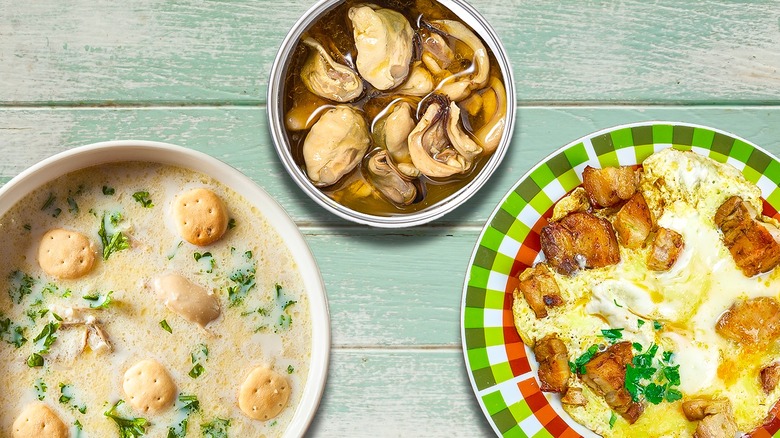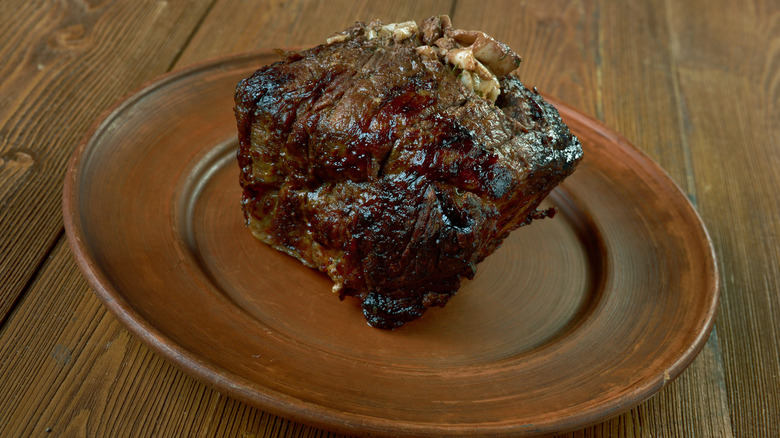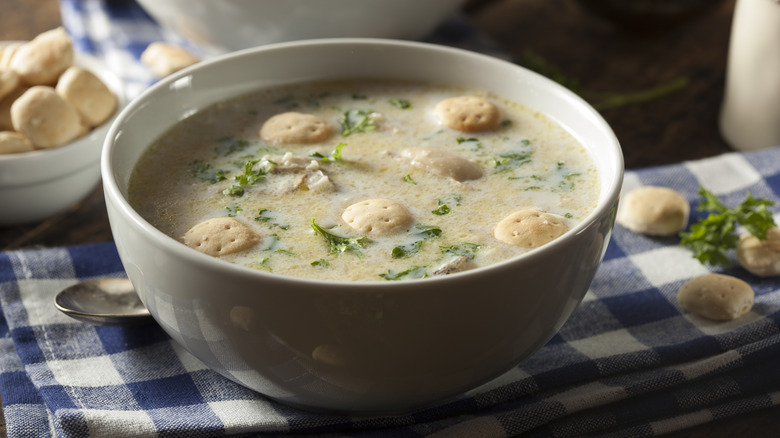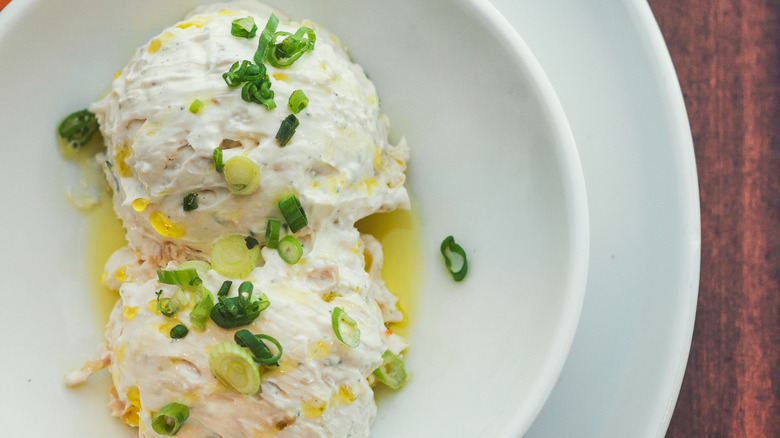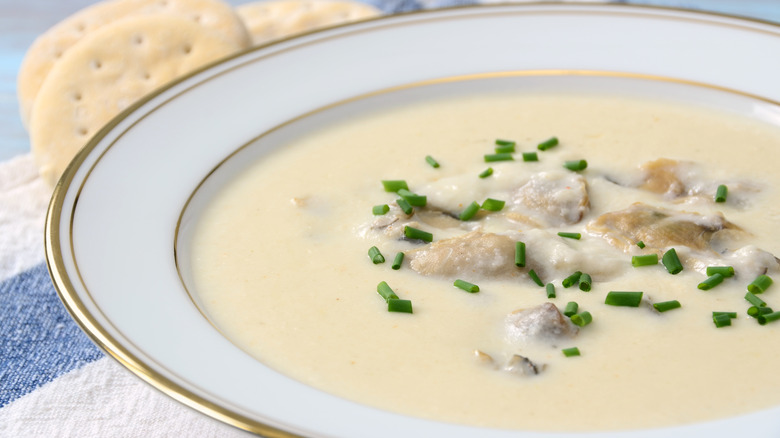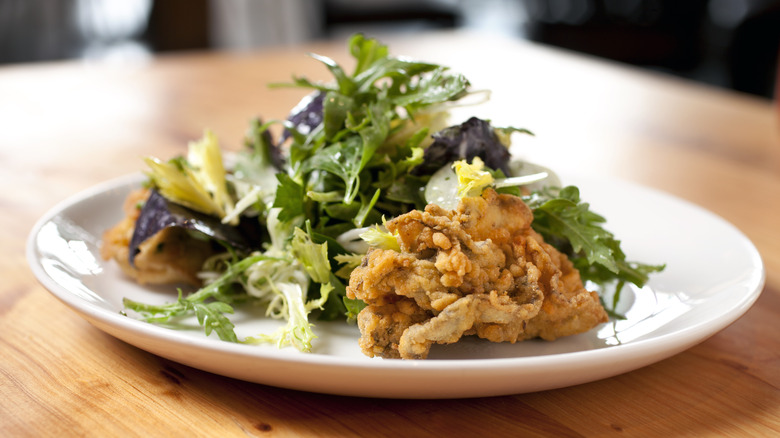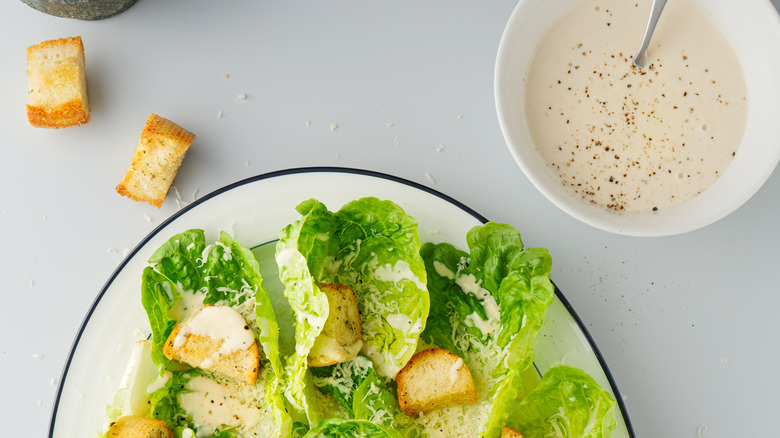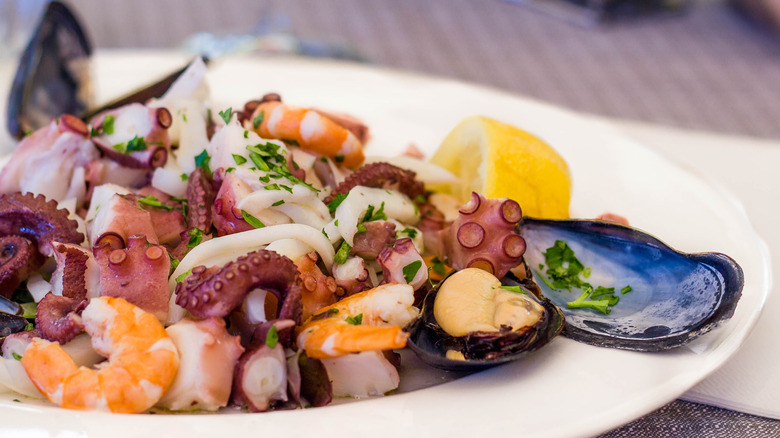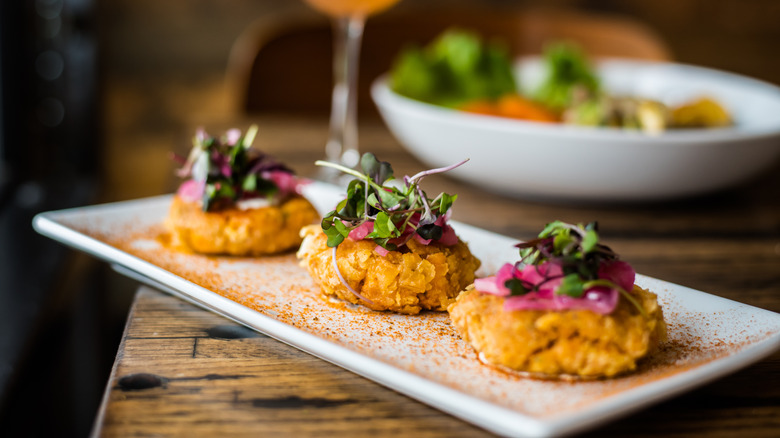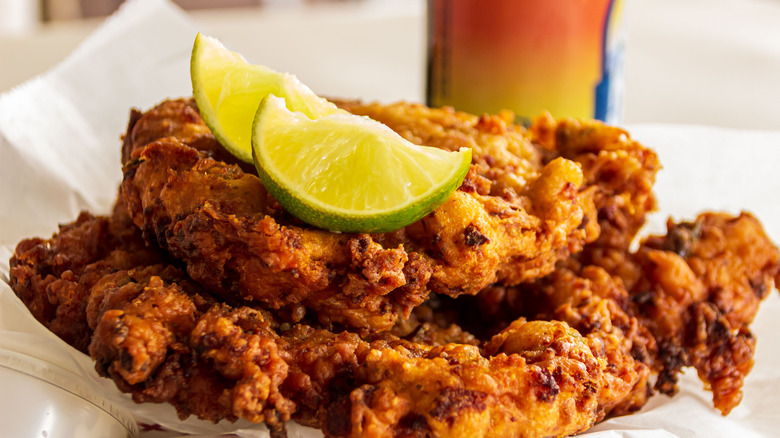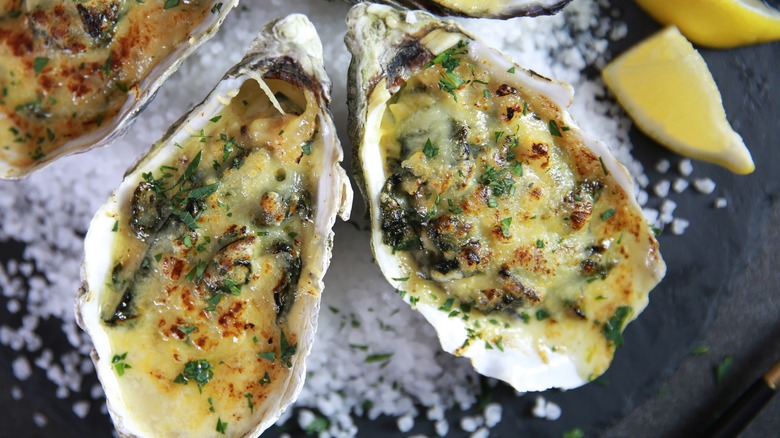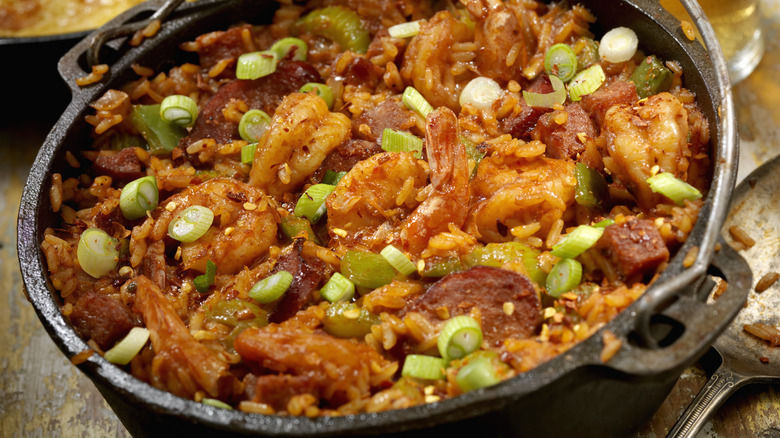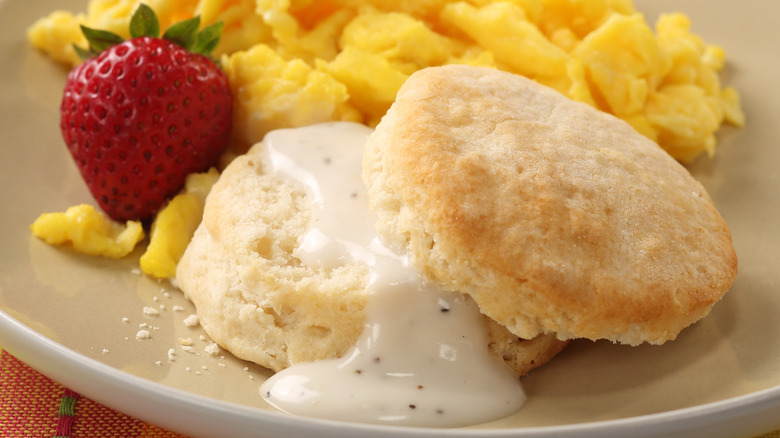15 Ways To Use Canned Oysters
Oysters have always been a staple food for people dwelling near coastlines. They're an easily-accessible source of protein that requires minimal effort to gather. As populations migrated inland, the ties to oysters remained strong, and packers devised ways to ship oysters in barrels via wagons and trains. That move required the financial risk of transporting and selling oysters before they spoiled. By the 1840s, cannery technology had progressed to a point where canning fresh oysters was a safe alternative to shipping live oysters without the risk of spoilage.
Today, you can find canned oysters of varying quality in high-end grocery stores and sketchy roadside gas station convenience stores, allowing people across wide geographic areas to eat oysters whenever they want, the myth of eating them only in months containing the letter R notwithstanding. There's nothing wrong with cracking a tin of these mollusks and snacking on them with some crackers and hot sauce, but there are other ways to enjoy them that you may never have thought of. As a rule of thumb, freshly harvested oysters will always have the most flavor, as the canned varieties get cooked as part of the packing process, but oysters from a can are a good fallback when fresh aren't available. Here are more than a few samples of what you can do with canned oysters, many of which I've prepared and served in restaurants.
Oyster ice cream
While its origins and "who made it popular" are up for debate, oyster ice cream is a real thing. Rumor has it that former First Lady Dolly Madison was quite fond of oyster ice cream, increasing its popularity among polite society and is perhaps the reason we know it today.
The recipe first appeared in an 1824 cookbook titled "The Virginia Housewife." In it, author Mary Randolph listed a recipe for Oyster Cream, the directions of which were to make what is essentially oyster chowder, strain it, and freeze it. The process involves making an oyster broth fortified with ham and onions. After reaching the proper flavor potency, one discards the oysters and flavoring elements, leaving a briny, smokey broth. That broth gets thickened with flour before finishing it with cream and eggs for richness. After which, the cooks would freeze the resulting smooth chowder.
This savory version has no sweetness and very little contemporary ice cream texture. As it isn't spun to incorporate air, it's a dense, creamy consistency, alive with the flavor of oysters and smoked ham. Cooks will serve a small portion of the ice cream garnished with a freshly shucked oyster to double down on the oyster flavor. While fresh oysters are always better, the recipe calls for a large amount of oysters and their brine, which one can arrive at easier by opening a can than by shucking a mountain of oysters.
Carpet bag steak
Ask the internet where a carpet bag steak originated, and the U.S., Wales, and Australia are all eager to claim it. It's safe to say that a carpet bag steak is one of the earlier forms of surf and turf, marrying ingredients from land and sea. The basic technique for making a carpet bag steak is to cut a pocket into a steak and stuff it with oysters, resembling a carpet bag — a type of suitcase popular in the mid-1800s.
The spartan approach simply stuffs the pocket with oysters, while other versions call for garlic butter or herb compound butter to lend richness to the dish. Any steak, from filet to sirloin, will work for this treatment. However, the best results come from a lean, tender cut, such as a flat iron, which also lends itself to easy stuffing because of its thicker middle but otherwise somewhat uniform thickness. The flat iron's depth makes it easier to heat the oysters without overcooking the steak. Using butter with the oyster stuffing can present problems when grilling or broiling, as flare-ups occur from the melting butter hitting the flames. It's best to pan-sear this steak, basting it with more butter to accompany the oyster-infused fat that leaks out. Canned oysters are a good choice for this treatment because they're already cooked, and you only need to warm them through, thus minimizing the chances of overcooking your steak.
Oyster stew
Coastal communities with readily available supplies of oysters found ways to incorporate them into their daily lives. Such is the case in the Low Country, which spans from the Carolinas to northern Florida. Oyster dishes could be a "struggle meal" when times were hard, or they could be part of celebratory feasts.
One example of such a dish is this oyster stew from Sean Brock. This recipe uses what would have been common pantry staples 100 years ago, such as bacon and benne seeds (similar to sesame), to create a deeply-flavored stew of oysters that were plentiful and easily harvested. Older recipes from when butter was a luxury tend to rely on alternative fat sources. Brock's stew starts with rendering bacon to create richness and a strong flavoring base. After sauteing some onions in the rendered fat, he builds a roux of both bene seed and wheat flour, adding nuttiness to the dish's base flavors before adding stock, oyster liquor, and finally, the oysters. This is another case where canned oysters can save you from considerable time and energy spent shucking. Green onions, lemon juice, hot sauce, and toasted benne seeds finish the dish with acidity, nuttiness, and bite.
Smoked oyster dip
Fans of clam dip, which gained popularity in the 1950s thanks to its appearance on the Kraft Music Hall television show, may be intrigued by its cousin, the smoked oyster dip. Neither originated as a standalone dish to be scooped with chips, but they were common as a base for canapes at parties before clam dip emerged onto the social scene.
You'll find smoked oysters on store shelves next to the unsmoked version, and either will work for this purpose, but the smoked version lends a little more depth of flavor. In its early forms, smoked oyster dip consisted of little but cream cheese and chopped oysters. As recipes evolved, chives came into play, adding a contrasting allium bite, and acidity from lemon juice or hot sauce followed suit. Today, you'll find many versions, many still relying on a cream cheese base, although lightened with mayonnaise or cottage cheese, with some additions such as pimentos or olives that play off the oysters' natural brininess.
Oyster chowder
While the Southeastern U.S. tends towards seafood stews, the Northeast is big on chowder. Although they're similar in preparation, a chowder is typically finished with cream or milk that adds richness and body. How popular are chowders? Andrew Zimmern starts Thanksgiving dinner with oyster chowder as part of his annual tradition.
Like a stew, chowder starts with sauteing vegetables and sometimes smoky meat, like bacon or ham, but butter is the main fat component for the next step, building a roux. The roux is a thickening agent for the chowder, giving it body and texture. After mixing flour into the butter and allowing it to cook, stock or oyster liquor contributes most of the liquid. After the chowder thickens and the starchiness of the roux cooks out via simmering, milk or heavy cream goes in to thin the chowder and give it richness. In the final few minutes, add your canned oysters just to warm them through so as not to overcook them.
Fried
Frying canned oysters is quite easy, and the fried oysters can serve as a standalone dish or as part of something bigger. There are several variations on breading, and you can choose one that suits you. Flour, buttermilk (or milk), and more flour; flour, buttermilk, and corn meal; buttermilk and cornmeal; or flour, egg, and breadcrumbs. You can add different seasonings to your breading, from savory, like thyme, garlic powder, or parsley, to spicy, like European paprika, ground Calabrian peppers, or cayenne.
Since the canned oysters are pre-cooked, they'll finish in the fryer oil faster than if they were raw. You can eat them as is, perhaps with a little remoulade sauce or tartar sauce. Another choice is to assemble the fried oysters on a roll for an oyster po'boy sandwich. Outside those realms, the fried oysters can serve as a garnish for a salad. You'll need crisp lettuce, such as Boston bibb, for a textural offset, and some bitterness from endive or radicchio provides a good flavor contrast. Thinking about how most people enjoy fried oysters, pairing the salad with a creamy, emulsified dressing satisfies that creamy element that tartare sauce or remoulade brings to the table.
Salad dressing
If you look at a classic Caesar salad dressing recipe, it's an emulsified blend of garlic, dijon, lemon, and anchovies (along with a few other ingredients). The anchovies bring an umami richness to the dressing, similar to what fish sauce adds to sauces in Southeast Asian cooking. There's little reason one couldn't swap out oysters for anchovies now that we're armed with the knowledge of the anchovy's purpose to achieve a similar goal with this Cesar dressing hack.
As oysters are an old-school salad garnish, it only makes sense that one could move the oyster element to the dressing. And this approach isn't limited to Caesar salads. You could add oysters to any dressing that would benefit from an umami boost, say, a roasted carrot vinaigrette. Texturally, the oysters would serve better in an emulsified dressing, but nothing is stopping you from adding them to a simple classic vinaigrette for an extra flavor pop. Canned oysters are perfect for adding to dressings, as they don't require cooking to make them food-safe before mixing them with other ingredients.
Seafood salad (Insalata di Mare)
It's important to point out that Insalata di Mare is considerably different from ceviche in that the ingredients are cooked. Well, most of them, anyway; some recipes call for cooking scallops by marinating them in acid. This classic Italian treatment of shellfish relies on an escabeche technique of marinating the ingredients after they cook.
In this case, shrimp, calamari, mussels, sometimes conch, and scallops bathe for a few hours or overnight in lemon juice, good olive oil, and garlic. Canned oysters are an easy replacement for any bivalves, or you can simply augment the recipe with them. Smoked oysters would also bring a non-traditional extra flavor depth to this treatment. Thinly sliced celery and fennel are often added to provide a crunchy textural offset to the shellfish and complete the salad, as are chopped fresh herbs like parsley or mint, which liven the flavor with a pop of green freshness.
Oyster cakes
Crab cakes are a well-known treatment for crustaceans, but who's to say the cooking style is limited to crab? The technique of mixing seafood with some flavoring elements and a binder, like egg and breadcrumbs, is fairly common across the coastal U.S. One version of oyster cakes from New Orleans follows the Maryland style cake, mixing oysters with flavorings like Worcestershire, mustard, and citrus with eggs, mayonnaise, and breadcrumbs to form a mixture that can be shaped into cakes for pan-frying. The usual accompaniment is some sort of creamy, mayonnaise-based sauce, like remoulade.
But that version of oyster cakes comes from viewing them from a U.S.-centric lens. Another common version in Singapore and Malaysia is a beignet-like dumpling filled with ground pork, shrimp, oysters, and peanuts. These oyster cakes are considered street food, and hawkers sell them to customers to eat the little fried dough balls as they walk.
Hangtown Fry
There aren't a lot of "authentically American" dishes that don't have roots from another country. Hangtown Fry is one of the outliers. Tall tales surround the dish's origins, but the story goes that its creation occurred in the mining town of Placerville, CA, during the California gold rush. Packers could ship oysters in barrels from Sacramento to the hills east of Sacramento, where Placerville, then known as "Hang Town," to feed hungry miners.
The story gets blurrier from there, but suffice it to say, a dish of fried bacon, fried oysters, and scrambled eggs arose from Hang Town. The simple description may make some recoil in terror, but the combination makes sense, considering how many dishes pair oysters and bacon. More refined versions of Hangtown Fry are served in omelet form, which makes the egg element more attractive. After visiting San Francisco, Anthony Bourdain regretted that a similar seafood stew wasn't commonly available in New York, so there's a testimony to the dish being greater than the sum of its parts.
Oyster fritters
Depending on your location, you might hear of an oyster croquette or an oyster fritter. They're essentially the same thing. Bahamian influences in southeast Florida made conch fritters a staple food there, and one can find some version of seafood fritter or croquette from the Florida Keys all across the Gulf Coast.
The key to a good fritter, like a good crab cake, is that there is more filling than dough. In that, chopped fish or shellfish, in this case, oysters, are commonly mixed with aromatics like onions, scallions, or garlic, seasoned with spices ranging from cayenne to allspice, then folded into a simple, tempura-esque batter of flour, water, egg, and baking powder. Scoops of the batter get deep fried and emerge with a crisp exterior and donut-like interior. Purists will eat these fritters as-is, but modern palates call for a sauce for dipping, and a mayonnaise-based sauce like remoulade accompanies them.
Oyster hash
Hash is a simple way to stretch a small amount of a few ingredients. Corned beef hash is an easily recognizable version of this concept that takes scraps and end cuts from the corned beef and mixes them with potatoes to go further, making a filling meal. The same concept is applicable to many foods, canned oysters included.
Starting with the obvious, oysters don't have the same flavor intensity as corned beef. So, augmenting the protein side of the equation with andouille or smoky ham will lend more depth to the flavor. After that, you can use your imagination to flesh out the rest. Some aromatics, like onions, will also boost the flavor. Then, you'll need a starchy component. Potatoes are a natural choice, but you could also use a starchy root vegetable like cooked yucca. Sweet potatoes add flavor and sweetness, but they lack the starch of potatoes, so mixing them with cooked potatoes is a good idea so your hash holds its form.
Brown your hash in a skillet for texture and caramelized flavor, then dress it up or down as you please. Hollandaise or crème fraiche are excellent toppings, as are eggs, or simply splashing your hash with some hot sauce.
Faux oysters Rockefeller
Oysters Rockefeller is a dish that first appeared on the menu at Antoine's Restaurant in New Orleans, Louisiana, in 1899. The dish was supposedly as rich as the richest man in the world at the time, John D. Rockefeller. Some stories surrounding its origin claim the dish is full of green ingredients to emulate money.
The key ingredients are spinach, fennel, parsley, celery, and chervil, with a splash of Pernod (a green, anise-flavored liqueur). This mixture is spooned on top of fresh oysters in their shell, topped with buttered breadcrumbs, and baked on a bed of rock salt until browned. Obviously, you can't recreate the oysters in their shells component with canned oysters, but you can create a facsimile.
Mixing the vegetable ingredients with canned oysters and placing them in a muffin tin or ramekin before topping them with breadcrumbs and baking can create individual Rockefellers for your meal. This method is advantageous in some aspects, such as not needing to shuck the oysters, dispose of the shells, or deal with leftover rock salt.
Pillau
Pilau is the lesser-known cousin of rice-centric dishes such as paella or jambalaya. Like jambalaya, it can take many forms, depending on the ingredients. Pillau is a staple dish among the Gullah Geechee people of the Low Country of the Carolinas, Georgia, and northern Florida. It's prepared by sauteeing aromatics, adding meat or flavorings, quickly toasting rice, then simmering the rice in a rich stock. Just before the rice finishes, cooks apply high heat to the bottom of the pan to create a crispy bottom layer that's considered the best part of the dish.
An oyster pillau is a straightforward affair. It starts with sautéing onions and scallions, sometimes with smoked ham or bacon, then adding the rice to toast in the pot quickly. The oyster liquor goes in next, along with seafood or chicken stock. Cover the pot and simmer until the rice is almost done. Then, add the canned oysters to the top of the rice, cover the pot again, and turn the heat up under the pot until you can hear the rice begin to crackle a bit. Scoop out a little toasted rice to accompany each portion, and garnish the dish with more sliced scallions.
Oyster gravy
Oyster gravy is to the Sea Islands of the Carolinas and Georgia what sausage gravy is to the rest of the South. When there's a staple ingredient, such as pork, or in this case, oysters, people will find a way to stretch it to feed large families or groups.
Start by sauteeing some onions or shallots in butter, adding white wine and lemon juice, and reducing them until almost dry. Then, add a stock and oyster liquor mixture and bring it to a boil. If you have them on hand, you can add fresh bay leaf and red pepper flakes to the stock. Whisk in a Beurre Manié to thicken, and then simmer the stock until it thickens and the starchy taste of the flour is gone. Add your canned oysters and finish the gravy with freshly ground black pepper. Oyster gravy is good served over toast, biscuits, or rice and garnished with a little chopped scallion.
